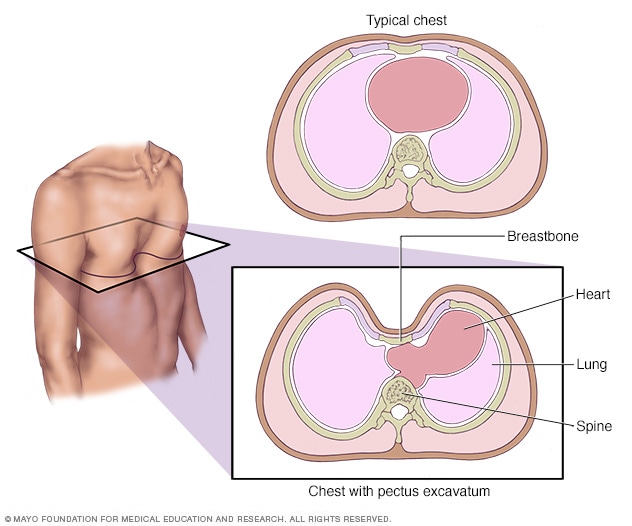Overview
Pectus excavatum

Pectus excavatum
Pectus excavatum is a condition in which the breastbone is sunken into the chest. If the condition is very serious, it can affect how well the heart and lungs work over time.
Pectus excavatum is a condition in which the breastbone is sunken into the chest. The sunken breastbone often can be seen shortly after birth. If the breastbone sinks a lot over time, the center of the chest may look like it's been scooped out. This change leaves a deep dent or dip. But many people with the condition just have a slight dip in the breastbone.
This condition also is known as funnel chest. But it can affect much more than the look of the chest. It also can cause symptoms such as shortness of breath, chest pain, and a fast-beating, fluttering or pounding heart. The symptoms tend to become worse during the teenage growth spurt.
The exact cause of pectus excavatum isn't clear. When the condition is serious, it can affect how well the heart and lungs work over time. But even mild pectus excavatum that causes a slight dip in the breastbone can make children feel self-conscious about their bodies.
Surgery to repair pectus excavatum can improve symptoms and the appearance of the chest. But surgery isn't right for everyone with the condition. Other treatment choices may include physical therapy and medical devices.
Symptoms
For many people with pectus excavatum, the only symptom is a slight dip in their chests. In some children, the dip becomes deeper during early puberty. It can keep getting deeper into adulthood.
In people with pectus excavatum, the breastbone may compress the lungs and heart. Symptoms can include:
- A fast-beating, fluttering or pounding heart.
- Chest pain.
- Loss of endurance that becomes worse over time.
- Shortness of breath or extreme tiredness during physical activity.
- A high-pitched whistling sound made while breathing that's triggered by exercise.
- Fainting or dizziness.
- Frequent infections of the upper airway.
- Stress and concern about how the chest looks.
When to see a doctor
See a healthcare professional if you or your child has any symptoms of pectus excavatum. This is key if the symptoms become worse or if the chest keeps becoming more sunken.
Causes
The exact cause of pectus excavatum isn't known. Some experts think it has to do with connective tissue called cartilage. Cartilage that connects the breastbone to the ribs may develop in an irregular way. Genes may play a role in this process.
Risk factors
Pectus excavatum risk factors may include the following:
- Having a family history of pectus excavatum.
- Living with a connective tissue condition such as Marfan syndrome, Ehlers-Danlos syndrome or osteogenesis imperfecta.
- Having a genetic condition such as Noonan syndrome or Turner syndrome.
Complications
Sometimes, pectus excavatum can lead to serious health issues called complications. The complications can affect the heart, lungs and mental health.
Heart and lung trouble
If the depth of the dent in the breastbone is serious, the lungs may not have enough room to fully expand. This also can squeeze the heart. The heart may be pushed to the left and may not pump blood as well as it should. This can cause symptoms such as being less able to exercise, shortness of breath, fast heart rate, and chest pain or pressure.
Self-image concerns
Many people who have pectus excavatum also tend to have a hunched-forward posture. Their lower ribs may flare out and their shoulders may be rounded. Many feel stress over how their bodies look. They may stay away from activities where the chest can be seen, such as swimming. They also might wear clothes that hide the dip in the chest.